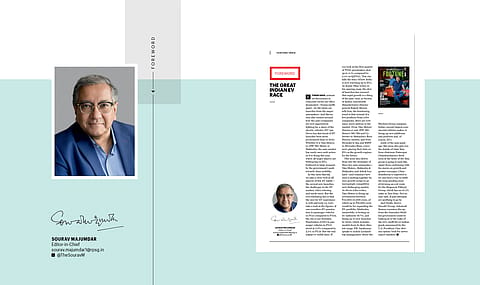The Great Indian EV Race: Why Carmakers Are Placing their Bets on Electric Vehicles as Growth Engines for the Future
In this Auto Special, we take a close look at all aspects of this EV battle—the several new launches, the challenges in the EV market, who’s winning, and much more. Beyond automobiles, this issue delves into Tata Sons chairman Natarajan Chandrasekaran’s third term at the helm of the Tata group and the options the Narendra Modi-led government is left with in the wake of the 50% tariff hit on Indian goods announced by the U.S. President.

This story belongs to the Fortune India Magazine september-2025-the-year-of-ev-launches issue.
THESE DAYS, animated discussions in corporate circles are often dominated — Trump tariffs apart — by the latest car launches from the major automakers. And discussion also centres around how the auto companies are now aggressively fighting for a share of the electric vehicles (EV) pie. Never has this trend of EV launches been more pronounced than in 2025. Whether it is Tata Motors or JSW MG Motor or Mahindra, the auto market has rarely seen such action as it is doing this year, where all major players are betting big on EVs, bolstered in large measure by the government’s push towards clean mobility.
In this Auto Special, we take a close look at all aspects of this EV battle—the several new launches, the challenges in the EV market, who’s winning, and much more. But the overwhelming fact is that the race for EV supremacy is well and truly on. Let’s take a look at the figures: if one considers EV penetration in passenger vehicles in FY25 compared to FY24, the rise is not dramatic. Penetration of EVs in passenger vehicles in FY25 stood at 2.6% compared to 2.3% in FY24. But the real impact is visible later. If you look at the first quarter of FY26, penetration shot up to 4.1% compared to 2.4% in Q1FY25. This rise tells the story of how India is now warming up to EVs. As Karan Dhar writes in his opening essay, the slew of launches has ensured that tepid growth is a thing of the past. And, as Society of Indian Automobile Manufacturers director general Rajesh Menon tells him, the heartening trend is that instead of a few products from a few companies, there are now many more options in the market. From Tata Motors’ Harrier.ev and JSW MG Motor’s MG M9 and Cyberster to Mahindra’s Born Electric models, and from Hyundai to Kia and BMW to Mercedes-Benz, everyone’s placing their bets on EVs as the growth engines for the future.
This issue also delves deep into the strategies of three key auto companies—Tata Motors, Mahindra & Mahindra, and Ashok Leyland—and examines how each is putting together its own growth recipe in an increasingly competitive and challenging market. As Nevin John writes, Tata Motors is lining up investments between ₹33,000-35,000 crore, of which up to ₹18,000 crore would be for expanding the EV portfolio. Mahindra, meanwhile, is betting on its ‘authentic SUVs’, and lining up 12 new launches by 2030, which includes models from its Born Electric range. P.B. Jayakumar speaks to Ashok Leyland’s top management where the Hinduja Group company, India’s second-largest commercial vehicles maker, is lining up new platforms and products and, of course, EVs.
Aside of the auto package, this issue also gets you the details of what Tata Sons chairman Natarajan Chandrasekaran’s third term at the helm of the Tata group is going to look like. Apart from continuing with his moves on growth and greater synergies, Chandrasekaran is expected to try and find a way to settle the long-pending issue of devising an exit route for the Shapoorji Pallonji Group, which has an 18.3% stake in Tata Sons. Not an easy task, if past attempts are anything to go by.
And finally, there’s Donald Trump. Ashutosh Kumar examines the options the Narendra Modi-led government could be looking at in the wake of the 50% tariff hit on Indian goods announced by the U.S. President. One obvious option: look for newer export markets.




